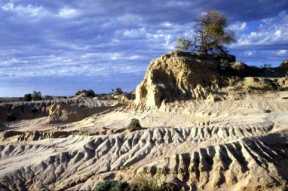







 |
 |
 |
 |
|||||
 |
 |
 |
||||||
 |
||||||||
Mungo Man, the skeleton found three decades ago in southeastern Australia,
remains at the center of two scientific stories. Recent DNA analyses of
the human skeleton found in 1974 by a geologist in the province of New
South Wales have revealed a genetic sequence that was not present in ancient
humans found in Africa nor is it found in modern human DNA. What’s more,
Mungo Man’s skeletal morphology is nearly identical to modern Aborigines
living in Australia. These claims have challenged the Out of Africa theory
that all modern humans supplanted a single species that arose in Africa.
The news has also dredged up the debate over the true age of the remains
and their implication for the spread of human occupation across the Australian
continent. Some scientists believe the skeleton in question
— dubbed Mungo Man after the dried-up lake bed in which it was found —
is the earliest evidence for modern men in Australia.
 The
geologist who found the skeleton, James Bowler of the University of Melbourne,
excavated the site with the help of Alan Thorne, an anthropologist from
the Australian National University. Today, Thorne asserts that the Mungo
Man skeleton is approximately 62,000 years old, making it the earliest
evidence for human occupation of the Australian continent. Bowler disagrees.
The
geologist who found the skeleton, James Bowler of the University of Melbourne,
excavated the site with the help of Alan Thorne, an anthropologist from
the Australian National University. Today, Thorne asserts that the Mungo
Man skeleton is approximately 62,000 years old, making it the earliest
evidence for human occupation of the Australian continent. Bowler disagrees.
[Dust-laden winds deposit
clays along the eastern shore of almost every lake in southeastern Australia
in formations called lunettes. The Walls of China formation, shown here,
is where Mungo Man was found in the Willandra Lakes region of New
South Wales. Photo by J. Houldsworth, AHC Photographic Collection.]
“To identify [the skelton’s] age at 62,000 years as the oldest evidence
of human presence in Australia is entirely misleading,” Bowler says. “On
the basis of current geological evidence, ignored by the dating team that
provided the 62,000-year age, the skeleton cannot be older than 50,000
years.”
Thorne and his colleagues published their age estimate in the Journal
of Human Evolution in 1999. However, Bowler firmly maintains that Thorne’s
age analysis ignored important geologic constraints and the skeleton’s
true age is closer to 40,000 years old. He published a response to Thorne’s
1999 paper that appeared in the May 2000 Journal of Human Evolution.
Bowler discovered the burial site of Mungo Man nearly three decades
ago when he was exploring the now-dry bed of Lake Mungo in the Willandra
Lakes region of New South Wales. He and Thorne worked together to dig an
11-meter trench along the side of the burial location to collect chemical
and micropedologic data from the stratigraphic layers that surrounded the
skeleton.
Since then the wind-deposited formation that buried the skeleton has
eroded by approximately 60 centimeters from its original height that reached
no more than 9 meters above the eastern side of the lake. Because of these
stratigraphic changes, Bowler argues that it is no longer possible to sample
the site as it was when the remains were found. In addition, he claims
that, in his 1999 paper, Thorne uses optically sourced luminescence data
taken from samples located 450 meters west and 350 meters east of the burial
site to obtain an age of 60,000 years. Yet the paper implies that they
were taken from the immediate burial area. Bowler also points out that
Mungo Man was found in a stratigraphic bed that crosses the whole Willandra
Lakes region and has been dated by others at approximately 45,000 years.
Thorne offers no contradictory evidence in his paper.
The Lake Mungo burial site is 2,700 kilometers away from the northwest
coast of Australia and more than 4,000 kilometers from the northwest coast
of New Guinea — the northern corner of the Australian continent 60,000
years ago — where the first humans are believed to have arrived from Asia.
Thorne believes that Mungo Man represents the minimum age when humans had
the ability to cross oceans “beyond the horizon.”
“There are artefacts below the level of burial, as yet not accurately dated,”
Bowlder says in response to claims that this skeleton represents the earliest
evidence for humans in New South Wales. “The international interest of
human occupation in Australia demands we get this story right.”
But the age issue does not necessarily impact the DNA story. “As a fully modern human, [the skeleton’s] comparison with Homo sapien records elsewhere does not depend on accurate age,” Bowler says. Anthropologists are now debating whether the genetic findings support the Out of Africa theory of evolution or a revised theory that suggests that while all people descended from a 1.5-million-year-old species that arose in Africa, they evolved into separate species that were later able to interbreed to form modern man. Thorne claims scientists discovery of now extinct genetic material in Mungo Man supports the latter, multiregional theory.
Laura Wright
 |
Geotimes Home | AGI Home | Information Services | Geoscience Education | Public Policy | Programs | Publications | Careers |